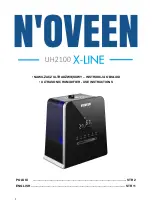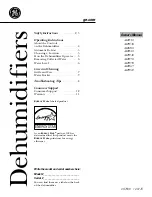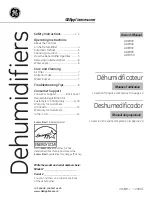
4
1.17. AVOID DANGEROUS ENVIRONMENTS.
Do Not operate this equipment in elevated areas without using fall protection equipment. Certain
applications of this equipment may require the use of scaffolding. Use of scaffolding creates
hazardous situations such as tripping and fall hazards which can result in serious injury or death
to operating personnel. Consult OSHA 29 CFR 1910 Subpart D.
1.18. AVOID DANGEROUS ENVIRONMENTS.
Do Not blast objects that are not properly secured. The blast operation can cause the blasted
object to shift or move. Extremely large objects to be blasted can create a crush hazard to
operating personnel which can result in serious injury or death. Properly secure the object to be
blasted.
1.19. AVOID DANGEROUS ENVIRONMENTS.
Do Not blast objects used to store flammable materials. The blast operation can cause sparks
which can ignite fumes or residual flammable materials inside enclosed containers which can
explode resulting in serious injury or death to operating personnel.
1.20. ELECTRICALLY GROUND EQUIPMENT.
Static electricity is generated by the abrasive flow through the blast hose. To prevent static
electrical shock to operating personnel only use static dissipating blast hose and install a
grounding strap on the abrasive blaster.
1.21. MAINTAIN VESSEL INTEGRITY.
Do Not operate this equipment with the pressure vessel damaged, or with any part of it worn or
damaged. Do Not operate this equipment in a condition that may cause failure of the pressure
vessel. See sections 1.22 through 1.31 below.
An Airprep System is a Pressurized Vessel. Alterations, damage, or misuse of the pressure vessel
can result in rupturing. Damaged or incorrect components used on the Airprep System pressure
vessel can result in rupturing. The compressed air inside a pressurized vessel contains a
dangerously high level of energy which can propel objects and cause serious injury or death.
1.22.
NEVER OPERATE OVER MAXIMUM WORKING PRESSURE.
Do Not operate this equipment above maximum allowable working pressure (MAWP) at
maximum operating temperature (°F) shown on the ASME nameplate attached to the vessel. See
Section 2.2.
1.23.
INSTALL PRESSURE RELIEF DEVICE.
Do Not operate this equipment without a pressure relief device in place. The ASME Code
requires that all vessels be equipped with pressure relief devices prior to installation. The
pressure relief device must be set at the maximum allowable working pressure of the pressure
vessel. See the ASME nameplate attached to the vessel typically located above the handway. See
Section 3.7 for information regarding the pressure relief valve.
1.24. NEVER OPERATE BEYOND ALLOWABLE TEMPERATURE RANGE.
Do Not operate this equipment above the maximum allowable temperature at the allowable
pressure or below the minimum design metal temperature (MDMT) shown on the pressure
vessel nameplate. The characteristics of the pressure vessel metal are weakened when the
temperature is outside the operating range. Operating the pressure vessel outside of allowable
temperature range can result in rupturing and cause serious injury or death.
1.25. ASME NAMEPLATE REQUIRED.












































